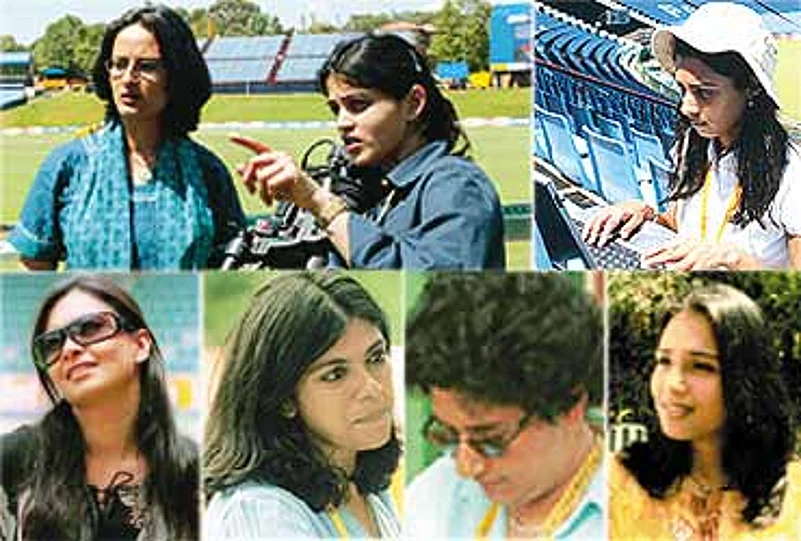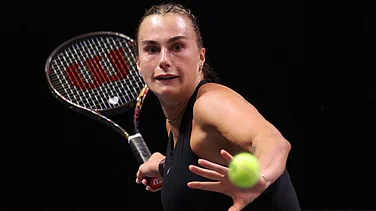
The Indian media corps is packed with women. Clockwise from top left: Sonali Chander and Gaurika Chopra of Star News; Anjali Joshi of cricketnext.com; Maria Goretti and Trishna Bose of MAX; Sharda Ugra of India Today; Deepti Menon of AajTak
"It's the ads," says Harshita Singh, 20, a Delhi management student. "There are more cricketers in ads nowadays than filmstars so all of us recognise them." There is another good reason to watch cricket: "No boyfriend will stop watching the game if you go out on a date. It's dumb to even expect that."
It's not just young women who are resorting to the well-worn strategy of if-you-can't-beat-them-join-them. Delhi's Nandini Chandra, mother of four, endured her fate as a wicket widow for years with exemplary forbearance. Nor did she succumb when her two sons drifted away into the game. But when her two daughters followed suit two years ago, she began to waver. And when the maid began visiting temples to pray for a win in the India-Pakistan match and the two drivers began to quarrel about whose turn it was to step out during the match, she surrendered. "Everywhere, people are asking each other about the score. So now I watch, even though I don't know anything about the game."
It's not long before women like Nandini turn gingerly into avid fans. Take Amita Bhatt and her neighbours in Ahmedabad. Once avid soap fans, the housewives' club now has a far more exciting agenda. "We order food and see the matches together," says Amitaben. Cricket is more than a game, it's a festival. "Everyone joins in realising how much fun it is—getting food from outside, celebrating, bursting crackers, cheering India." And like all festivals, the game breeds its superstitions: "They don't allow me to watch India batting, for everyone believes that if I am watching the game wickets start falling," says Amitaben, who makes up "by watching every ball that our bowlers bowl".
At half her age, Delhi entrepreneur Anisha Gupta brings the same curious mix of enthusiasm and superstition into her passion for cricket. She has her lucky spot in the room from which she won't budge till the end of the match, while her friend, mba student Devika Khosla, has to only walk into a room for an Indian batsman to hit a six or a four. When all fails, they rely on the good ol' fallback, prayer. "Really good vibrations work," assures Devika. And yet the two women discuss with their bemused male friends not only the nuances of the game—from umpire David Shepherd's decisions to Shoaib Akhtar's scorchers—but take a ball-by-ball interest in every match.
One reason why the pair is so enthusiastically mastering cricket jargon and rules, closely following the pitch and weather reports, is because they have joined a betting circle. Neither has made much money so far—Devika is up by ten grand, while Anisha lost money on Pakistan-England. But the new bond she has with her father outweighs her losses."He's really happy I share his passion."
Cricket is now a family soap. "Who wants to watch serials when a match is on and India is playing?" asks Swati Kapoor, 25, a Calcutta executive. It's a welcome break from the daily grind. For Ummal Momeen, 24, and her mother Mariam Beevi in Chennai, it's about access to a TV. Ummal is glued to the little b&w Videocon TV called Sachin and does not miss a single match. "Mandira looks good but that's about it," she says with all the insouciance of a veteran addict. Her mother is more grudging about her fondness for the game: "It is such a waste of time. We are a nation of lazy people, so we watch cricket." But she confesses that she almost cried when a Dilhara Fernando delivery struck a blow on her favourite Ramnaresh Sarwan's head, only recovering when he returned to bat valiantly.
It's also about celebration—the beers, firecrackers and the sweets. But above all, it's about patriotism. Especially for a generation of young women who find little to cheer about, these personable men in blue are an intoxicating reminder about what Indians can do in the world.



















